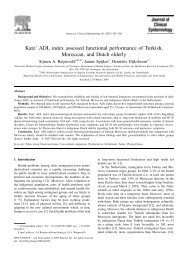Effects of Amlodipine and Lisinopril on Left Ventricular Mass ... - share
Effects of Amlodipine and Lisinopril on Left Ventricular Mass ... - share
Effects of Amlodipine and Lisinopril on Left Ventricular Mass ... - share
Create successful ePaper yourself
Turn your PDF publications into a flip-book with our unique Google optimized e-Paper software.
<str<strong>on</strong>g>Effects</str<strong>on</strong>g> <str<strong>on</strong>g>of</str<strong>on</strong>g> <str<strong>on</strong>g>Amlodipine</str<strong>on</strong>g> <str<strong>on</strong>g>and</str<strong>on</strong>g> <str<strong>on</strong>g>Lisinopril</str<strong>on</strong>g> 115to that <str<strong>on</strong>g>of</str<strong>on</strong>g> the <str<strong>on</strong>g>of</str<strong>on</strong>g>fice blood pressure, the blood pressuredecrease in both treatment groups was c<strong>on</strong>sidered to beequal [17].Comparis<strong>on</strong> with other studiesThe results <str<strong>on</strong>g>of</str<strong>on</strong>g> eight published r<str<strong>on</strong>g>and</str<strong>on</strong>g>omized c<strong>on</strong>trolledtrials c<strong>on</strong>cerning the effects <strong>on</strong> LVMI <str<strong>on</strong>g>and</str<strong>on</strong>g> comparingACE inhibitors <str<strong>on</strong>g>and</str<strong>on</strong>g> calcium antag<strong>on</strong>ists are given inTable VI. According to recently designed criteria for trials<strong>on</strong> regressi<strong>on</strong> <str<strong>on</strong>g>of</str<strong>on</strong>g> left ventricular hypertrophy, n<strong>on</strong>e <str<strong>on</strong>g>of</str<strong>on</strong>g>these eight published studies can be c<strong>on</strong>sidered a trial fordefinite c<strong>on</strong>clusi<strong>on</strong>s about inter-agent differences [11].All studies were r<str<strong>on</strong>g>and</str<strong>on</strong>g>omized, between-agent comparis<strong>on</strong>s,in women <str<strong>on</strong>g>and</str<strong>on</strong>g> men, <str<strong>on</strong>g>and</str<strong>on</strong>g> used echocardiography toassess regressi<strong>on</strong> <str<strong>on</strong>g>of</str<strong>on</strong>g> left ventricular hypertrophy (selecti<strong>on</strong>criteria used). However, <strong>on</strong>ly three [8–10] weredouble-blind, <strong>on</strong>ly <strong>on</strong>e [18] had a sufficient follow-up (1year), <str<strong>on</strong>g>and</str<strong>on</strong>g> five <str<strong>on</strong>g>of</str<strong>on</strong>g> eight studies [8, 18–21] analysedrelati<strong>on</strong>s between changes in blood pressure <str<strong>on</strong>g>and</str<strong>on</strong>g> changesin LVMI. The present study fulfilled all the criteriamenti<strong>on</strong>ed above <str<strong>on</strong>g>and</str<strong>on</strong>g>, in additi<strong>on</strong>, was the <strong>on</strong>ly studywhich included previously untreated patients. There areno studies, including the present, which fulfilled the lasttwo criteria: including an ethnically diverse populati<strong>on</strong><str<strong>on</strong>g>and</str<strong>on</strong>g> at least 150–200 patients per treatment arm. Toexclude the possibility <str<strong>on</strong>g>of</str<strong>on</strong>g> inter-agent differences, it isindeed important to include larger numbers <str<strong>on</strong>g>of</str<strong>on</strong>g> patients.The relatively large 95% c<strong>on</strong>fidence intervals <str<strong>on</strong>g>of</str<strong>on</strong>g> thedifferences in LVMI in both treatment groups found in thepresent study also point at a n<strong>on</strong>-optimal precisi<strong>on</strong>. EvenDahlöf et al. [22], in their meta analysis comprising over2000 patients also ran into some problems, e.g. <strong>on</strong>ly 17%<str<strong>on</strong>g>of</str<strong>on</strong>g> the studies were r<str<strong>on</strong>g>and</str<strong>on</strong>g>omized, follow-up was <strong>on</strong> average10 m<strong>on</strong>ths <str<strong>on</strong>g>and</str<strong>on</strong>g> number <str<strong>on</strong>g>of</str<strong>on</strong>g> patients per study was average21, etc. More accurate estimates <str<strong>on</strong>g>of</str<strong>on</strong>g> the effects can beobtained from meta-analyses <str<strong>on</strong>g>of</str<strong>on</strong>g> well-designed parallelgroup comparative studies. The compiled data <str<strong>on</strong>g>of</str<strong>on</strong>g> thestudies summarized in Table VI suggest that there are nodifferences between calcium antag<strong>on</strong>ists <str<strong>on</strong>g>and</str<strong>on</strong>g> ACEinhibitors with respect to regressi<strong>on</strong> <str<strong>on</strong>g>of</str<strong>on</strong>g> LVMI. Devereux<str<strong>on</strong>g>and</str<strong>on</strong>g> Dahlöf [11] have suggested the following types <str<strong>on</strong>g>of</str<strong>on</strong>g>studies for the future for establishing the therapeuticusefulness <str<strong>on</strong>g>of</str<strong>on</strong>g> treating LVH per se <str<strong>on</strong>g>and</str<strong>on</strong>g> not just forlowering the blood pressure: (1) Medium-sized studieswith 300–400 patients followed up for at least 6 m<strong>on</strong>ths todetermine definitively whether inter-agent differences inreducti<strong>on</strong> <str<strong>on</strong>g>of</str<strong>on</strong>g> LV mass exist, <str<strong>on</strong>g>and</str<strong>on</strong>g> (2) large, l<strong>on</strong>g-term trialswith at least 1200 patients followed up for a minimum <str<strong>on</strong>g>of</str<strong>on</strong>g>4 years to determine whether LVH reversal improvesprognosis over <str<strong>on</strong>g>and</str<strong>on</strong>g> above blood pressure reducti<strong>on</strong> <str<strong>on</strong>g>and</str<strong>on</strong>g>the type <str<strong>on</strong>g>of</str<strong>on</strong>g> treatment used.In <strong>on</strong>ly two [8, 19] <str<strong>on</strong>g>of</str<strong>on</strong>g> the eight studies summarized inTable VI, a significant relati<strong>on</strong> between changes in bloodpressure <str<strong>on</strong>g>and</str<strong>on</strong>g> changes in LVMI could be found. In thepresent study, the changes in LVMI were significantlyrelated to the changes in blood pressure <str<strong>on</strong>g>and</str<strong>on</strong>g> this relati<strong>on</strong>proved to be str<strong>on</strong>ger for ambulatory blood pressure thanfor <str<strong>on</strong>g>of</str<strong>on</strong>g>fice blood pressures. If regressi<strong>on</strong> <str<strong>on</strong>g>of</str<strong>on</strong>g> LVMI isc<strong>on</strong>sidered to be a good predictor <str<strong>on</strong>g>of</str<strong>on</strong>g> prognosis, theseresults suggest that prognosis is more str<strong>on</strong>gly related tochanges in ambulatory blood pressures.Diastolic fillingRegressi<strong>on</strong> <str<strong>on</strong>g>of</str<strong>on</strong>g> left ventricular mass is usually associatedwith improvement <str<strong>on</strong>g>of</str<strong>on</strong>g> diastolic filling. In this study, E/Aratio did not change significantly; changes in E/A ratiowere not related to the pretreatment level, <str<strong>on</strong>g>and</str<strong>on</strong>g> there was avery weak relati<strong>on</strong> between changes in LVMI <str<strong>on</strong>g>and</str<strong>on</strong>g>changes in E/A ratio. These results may be explained bythe fact that in neither <str<strong>on</strong>g>of</str<strong>on</strong>g> the treatment groups was E/Aratio markedly abnormal before the start <str<strong>on</strong>g>of</str<strong>on</strong>g> treatment. Itcan be seen from Table VI that statistically significantchanges in E/A ratio were seen in <strong>on</strong>ly two <str<strong>on</strong>g>of</str<strong>on</strong>g> six studies[18, 20].The lack <str<strong>on</strong>g>of</str<strong>on</strong>g> hypertrophy at baseline in the majority <str<strong>on</strong>g>of</str<strong>on</strong>g>our patient populati<strong>on</strong> is comparable to that in theTOMHS study [24], J. D. Neat<strong>on</strong> et al.’s work [25] <str<strong>on</strong>g>and</str<strong>on</strong>g>the latest issue <str<strong>on</strong>g>of</str<strong>on</strong>g> Circulati<strong>on</strong> (1997) [6]. We would like topoint out that prevalence <str<strong>on</strong>g>of</str<strong>on</strong>g> hypertrophy in mild tomoderate hypertensi<strong>on</strong> in these primary care patients isvery low.In this study, no differences were found in the changesin isovolumetric relaxati<strong>on</strong> time (IVRT) (decreasedsignificantly during lisinopril treatment but not inresp<strong>on</strong>se to amlodipine), peak early filling (E-peak) <str<strong>on</strong>g>and</str<strong>on</strong>g>early accelerati<strong>on</strong> time (EAT) within the groups. However,the changes in IVRT, E-peak <str<strong>on</strong>g>and</str<strong>on</strong>g> EAT weresignificantly related to their baseline values, which meansthat improvement can be seen after treatment with bothagents at higher levels <str<strong>on</strong>g>of</str<strong>on</strong>g> dysfuncti<strong>on</strong>. Decelerati<strong>on</strong> <str<strong>on</strong>g>of</str<strong>on</strong>g> theearly filling velocity is str<strong>on</strong>gly related to left ventricularcompliance [22]. In both treatment groups, significant <str<strong>on</strong>g>and</str<strong>on</strong>g>similar changes in early decelerati<strong>on</strong> time (EDT) <str<strong>on</strong>g>and</str<strong>on</strong>g>pressure half time (PHT) were seen, whereas peak earlyfilling (E-peak) remained unchanged. Furthermore,changes in EDT <str<strong>on</strong>g>and</str<strong>on</strong>g> PHT were significantly related tothe baseline values. Thus, although the E/A ratioremained unchanged, the analysis <str<strong>on</strong>g>of</str<strong>on</strong>g> these sec<strong>on</strong>daryparameters shows that both amlodipine <str<strong>on</strong>g>and</str<strong>on</strong>g> lisinopril alterdiastolic filling <str<strong>on</strong>g>and</str<strong>on</strong>g> that improvement <str<strong>on</strong>g>of</str<strong>on</strong>g> diastolic filling isdependent <strong>on</strong> the level <str<strong>on</strong>g>of</str<strong>on</strong>g> impairment before treatment.As far as the mechanism <str<strong>on</strong>g>of</str<strong>on</strong>g> regressi<strong>on</strong> <str<strong>on</strong>g>of</str<strong>on</strong>g> LVH isc<strong>on</strong>cerned, in the experimental studies it has been shownthat pharmacologic agents that interfere with theadrenergic nervous system may induce regressi<strong>on</strong> inmyocardial mass due to reducti<strong>on</strong> in myocyte size, butBLOOD PRESSURE 1998








